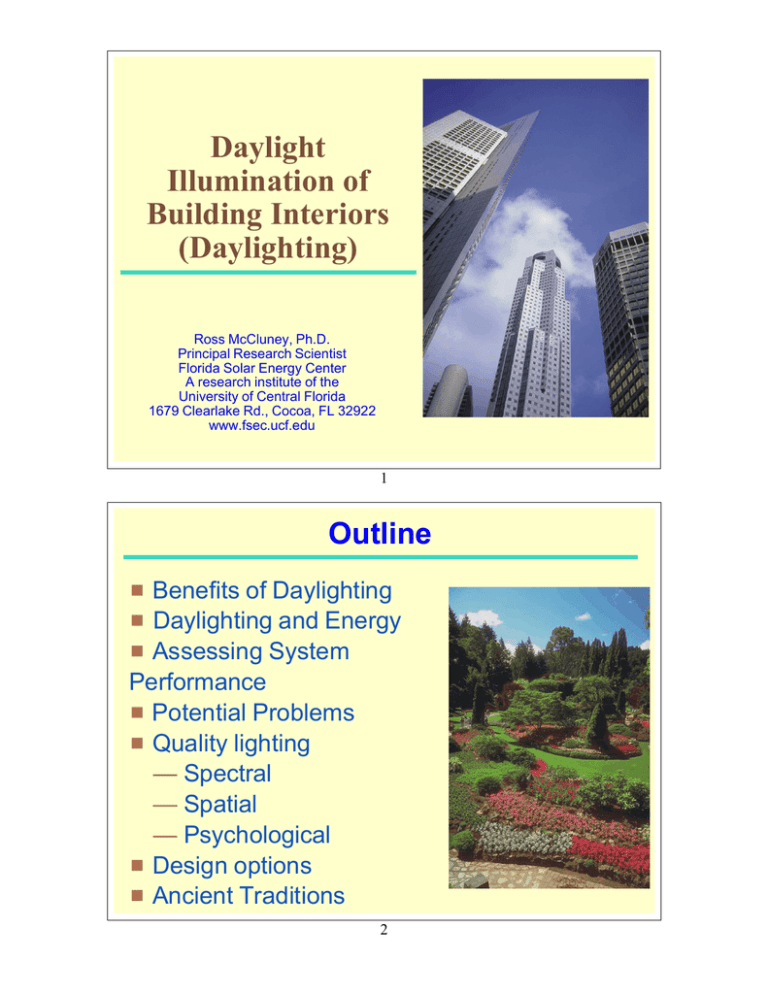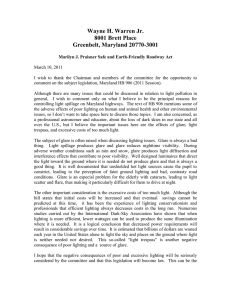Daylight Illumination of Building Interiors (Daylighting)
advertisement

Daylight Illumination of Building Interiors (Daylighting) Ross McCluney, Ph.D. Principal Research Scientist Florida Solar Energy Center A research institute of the University of Central Florida 1679 Clearlake Rd., Cocoa, FL 32922 www.fsec.ucf.edu 1 Outline # Benefits of Daylighting # Daylighting and Energy # Assessing System Performance # Potential Problems # Quality lighting — Spectral — Spatial — Psychological # Design options # Ancient Traditions 2 Daylighting Benefits 3 Daylight Illumination P Cool, natural daylight has good color rendering P Daylight is healthy, has psychological benefits P Daylighting can displace electric lighting, saving energy P Reduce air pollution, global warming, and dependence on foreign sources of energy 4 Goals of daylighting design P Provide good quality daytime interior: < illumination < view P Provide good visual comfort for occupants < Happy people are productive people < Productive people improve output P Avoid common problems < Glare < Overheating P Displace daytime electric lighting and save electrical energy costs P Occupancy is critical 5 Daylighting and Energy 6 Daylighting and Electric Lighting Comparison To deliver 1000 Lumens per square meter Incandescent light requires 133.3 W/m2 of illuminated area Flourescent light requires 26.67 W/m2 2.78 W/m2 Daylight requires Ratios of energy cost, electric lighting to daylighting: Incandescent lighting 133.3÷2.78 = 48 to 1 Fluorescent lighting 26.67÷2.78 = 9.6 to 1 Savings not around the clock all year long. But an energy efficient window does not cost much energy. Daylighting is generally the single greatest energy saving strategy one can have in an otherwise energy efficient office building. 7 How daylighting saves energy Electric lighting system Luminous efficacy Ks / Lumens of light Watts of electricity Unit: Lm/W Daylight radiation luminous efficacy Kr = 100 to 160 Lm/W In comparison: Fluorescent lighting system Ks = 40-60 Lm/W Incandescent lighting Ks = 8-12 Lm/W In the middle of a bright day, let’s provide 1000 Lm/m2 of illumination. (This is about 100 ft-candles) 8 Providing 1000 Lux of Illumination To provide 1000 Lumens per square meter, and remove the heat produced by the lighting with an air conditioner C.O.P. of 3 using: P Incandescent light requires P 1000 Lm ÷ 10 Lm/W = 100 watts of electricity per sq. m. P Plus 100 ÷ 3 = 33.3 W for heat removal P Total: 133.3 W/m2 P Flourescent light requires P 1000 ÷ 50 = 20 watts of electricity per sq. m. P Plus 20 ÷ 3 = 6.67 W for heat removal P Total: 26.67 W/m2 P Daylight produces a heat gain of P 1000 ÷ 120 = 8.33 watts P and 8.33 ÷ 3 = 2.78 watts for heat removal P Total: 2.78 W/m2 9 Summary: To deliver 1000 Lumens per square meter Incandescent light requires 133.3 W/m2 Flourescent light requires 26.67 W/m2 Daylight requires 2.78 W/m2 Ratios of energy cost, electric lighting to daylighting: Incandescent lighting 133.3÷2.78 = 48 to 1 Fluorescent lighting 26.67÷2.78 = 9.6 to 1 These savings with daylighting do not take place around the clock all year long. An energy efficient window does not cost much energy. Daylighting is generally the single greatest energy saving strategy one can have in a relatively energy efficient office building. 10 Assessing System Performance 11 Solar Lighting System (SLS) Performances Illumination Quality Quantity Color rendering Light level Glare avoidance Energy Displace electric lighting Direct energy savings Coverage area Thermal energy impacts Solar gain Net energy impact User satisfaction & productivity ($) Conduction heat transfers Cost of energy Annual dollar savings 12 Potential Problems P Glare P Overheating, draftiness P Noise P Physical impacts P Privacy 13 Glare Primer P Disability glare P Discomfort glare 14 15 16 P Disability Glare P Light reflects off of the target or otherwise masks or reduces contrast of the target, disabling the visual task. P Example: Window reflected from computer screen P Discomfort Glare P Light, usually from the side, is brighter than that of the visual task, enters the eye and causes visual discomfort. P Example: Bright window to the side, much brighter than the computer screen or the book you’re trying to read, or the person seated opposite you. You can see the true visual target, but not clearly. After a while you get a headache. Removal of glare source induces comfort. 17 Glare Sources ! The sun ! Reflected beam sunlight ! Bright window surrounded by dark walls and furnishings ! Bare electric lamps, incandescent and fluorescent ! Poorly designed electric luminaires ! Improperly used luminaires 18 Dealing with Glare from Windows P Direct beam sunlight P Path of the sun through the sky P Avoiding beam radiation P Managing beam radiation P Even diffuse sky light can be a problem 19 WINTER SUMMER Sun rises south of due east, sets south of due west, and is low in the sky at noon Sun rises north of due east, sets north of due west, and is high in the sky at noon Shade: southwest to west to protect west window on warm winter days Shade: overhang for noon east to northeast morning west to northwest afternoon 20 Direct Beam Solar Radiation Can produce discomforting glare and localized overheating, as well as add to the air conditioning bill. 21 Avoiding Direct Beam 22 Orientation & Shading Strategies N Minimize East and West Exposures Wide overhangs Fence Garage Closet Buffer East and West Exposures 23 Block solar gain before it reaches the window 24 Utility room Sunpath on Summer Solstice at a southern latitude 25 Summer Sun — Morning and Afternoon East-facing West-facing 26 Glare from diffuse daylight P Bright window with dark surround produces glare P Window brightness the same regardless of size P Room brightness a combination of total daylight admitted and electric illumination P Small windows, dark walls, and inadequate electric lighting results in poor luminance balance – glare P Large windows, bright walls, minimal electric lighting provides better quality and good energy savings 27 Quality Lighting P Spectral P Spatial P Psychological 28 Solar Spectrum 1.6 1.4 Solar spectrum 1.2 1.0 Human eye sensitivity (Visible portion of the spectrum) 0.8 0.6 0.4 0.2 UV VIS 0.0 0 500 NIR 1000 1500 2000 2500 Wavelength in nm Near Infrared (NIR) Ultraviolet (UV) 29 Color 8 Illuminant with its own characteristic color 8 Apparent object color Source color Object with spectral reflectance R(8) 30 Reflected light whose color is defined by the color of the incident beam and the spectral reflectance (inherent color) of the object 72 CIE 1931 Chromaticity Coordinates 0.9 0.8 0.7 520 530 510 540 Locus of monochromatic colors 550 Green 560 0.6 500 570 0.5 580 y 0.4 0.3 White 590 600 490 620 830 Red 0.2 480 0.1 0.0 0.0 470 Blue 360 0.1 0.2 0.3 0.4 0.5 0.6 0.7 0.8 x 31 Source Color Rendering CIE 1931 chromaticity coordinates 0.9 0.8 520 510 530 540 0.7 550 Green 0.6 560 500 0.5 y 570 Locus of blackbody 2,856 colors 0.4 D65 0.3 490 0.2 0.1 0.0 0.0 580 3,500K 590 600 A 2,000K 620 1,500K Red 4,500K 830 500K 6,500K 10,000K White 480Blue 100,000K 470 360 0.1 0.2 0.3 0.4 x 32 0.5 0.6 0.7 0.8 High Quality Spatially P Glare free P Adequate quantity P Shadows for good depth and shape perception 33 High Quality Psychologically P In our evolutionary past, information on time of day, seasonal changes in vegetation, in weather, and in other forms of environmental ‘data' had a pronounced influence on survival and health. P Thus, it made sense to pay attention to changes in daylight that provided < time cues < assessment of cloud formations for information about future weather conditions P These events influenced our ancestors' daily decisions, such as where to sleep at night, as well as much more difficult decisions such as where to look for food next week. P It is not surprising, therefore, that loss of natural information on time of day has been implicated in the poor recovery of patients in windowless intensive care units. P “Once you start thinking about it, [daylighting] design makes perfect sense." "We didn't evolve in a sea of gray cubicles." — Judith Heerwagen, principal of J. H. Heerwagen and Associates and senior scientist at the Pacific Northwest National Laboratory in Seattle. 34 Humans need connections with the outdoors, with Nature P It’s built into our genetic makeup P It promotes health and a sense of well-being P It makes us happier and more productive P (as if worker productivity were the most important measure of a building’s performance) P Even photographs of Nature on the wall have been proven helpful P If we cannot live outdoors, at least let’s introduce some of the outdoors to the indoors 35 Design Options 36 Solar Lighting Systems Solar Photovoltaic Lighting Systems Solar Optical Lighting Systems Roof monitor Active collection and distribution system Photovoltaic system Skylight or solar pipe (roof fixture) Conventional window Special wall daylighting system View glazing 37 Which daylighting strategy to use? P Close to an outside wall, you can’t beat a window. P Just below the roof, skylights and clerestories are good. P Away from the envelope of the building, you have to be a bit more creative, using light piping in one form or another. P Glare mitigation and avoiding overheating in summer are important, even critical. 38 Electric Lighting System Controls for Daylighting ! On/Off switching - Off when daylight is enough ! Dimming - Photosensor dims the electric lights, saving energy, when daylight enters ! Window controls - Large, bright windows, lights switched off in daytime, windows with adjustable shades to reduce brightness and mitigate glare ! Occupancy sensors turn lights off when room is empty ! The major problems: - “Tuning” or adjusting the dimming system - Occupant desire for control - Counter-productive controlling practices 39 Costs and Benefits 40 How much can I afford to pay for daylighting? P Cost can seem a very limiting strategy, at least until the price of energy increases dramatically. P To see how much you can afford to put into a daylighting system, do a quick calculation of how much electric lighting (and reduced A/C) energy you can save. P Put a dollar value on the saved lighting & A/C energy in a year P Calculate the simple payback time in years P = Extra cost divided by the annual savings P But there’s more to it than that. How much can you afford not to pay for daylighting? P When the lights go out or the building is too expensive to inhabit without shutting down the A/C P Long term security dictates the most energy efficiency and protection against blackouts you can afford 41 Making the decision to use daylighting P Payback times of a few years translate to excellent returns on the investment. P Return on investment . 1/payback time P If your energy-only payback time is less than 10 years, the answer is obvious. P Even if it is longer than 10 years, or even 20 years: P Productivity and mental health have value. P Don’t forget the psychological and aesthetic values to daylighting too. P Ask your client to help you come up with an approximate dollar value for increased productivity and happier employees. < Then add this to the annual dollar savings when calculating payback time and ROI. P Alert business managers know the value of happy, daylit employees. Now you do too. 42 Getting it Right ! The simplest strategy is usually the best, and the cheapest. ! But poor lighting quality can be a terrible side-effect. ! Mitigating glare with extra shades, wing walls, and light controls of other kinds will increase installation costs. ! Much glare avoidance can be accomplished in the design of the building and won’t significantly add to its cost. ! Make glare avoidance part of the artistic, architectural uniqueness of the design and it won’t really cost extra. 43 Ancient Traditions P There was daylighting before electric lighting P We evolved under tree canopies and in open plains P Our eyes are adapted to seeing daylight, not flickering, spectrally distorted, electric lighting P Electric lighting hurts Mother Nature P Daylighting is free and healthful P Perhaps we need to reexamine the ancient traditions of living lightly on the land. 44 Final Points ! Daylighting offers excellent quality, augments the aesthetic design of the building and interior spaces ! Color-rendering is unsurpassed ! Building and window system design critical to successful daylighting ! Significant energy savings and enhanced worker productivity are possible with good design ! The Illuminating Engineering Society of North America offers a comprehensive Daylighting Guide 45






